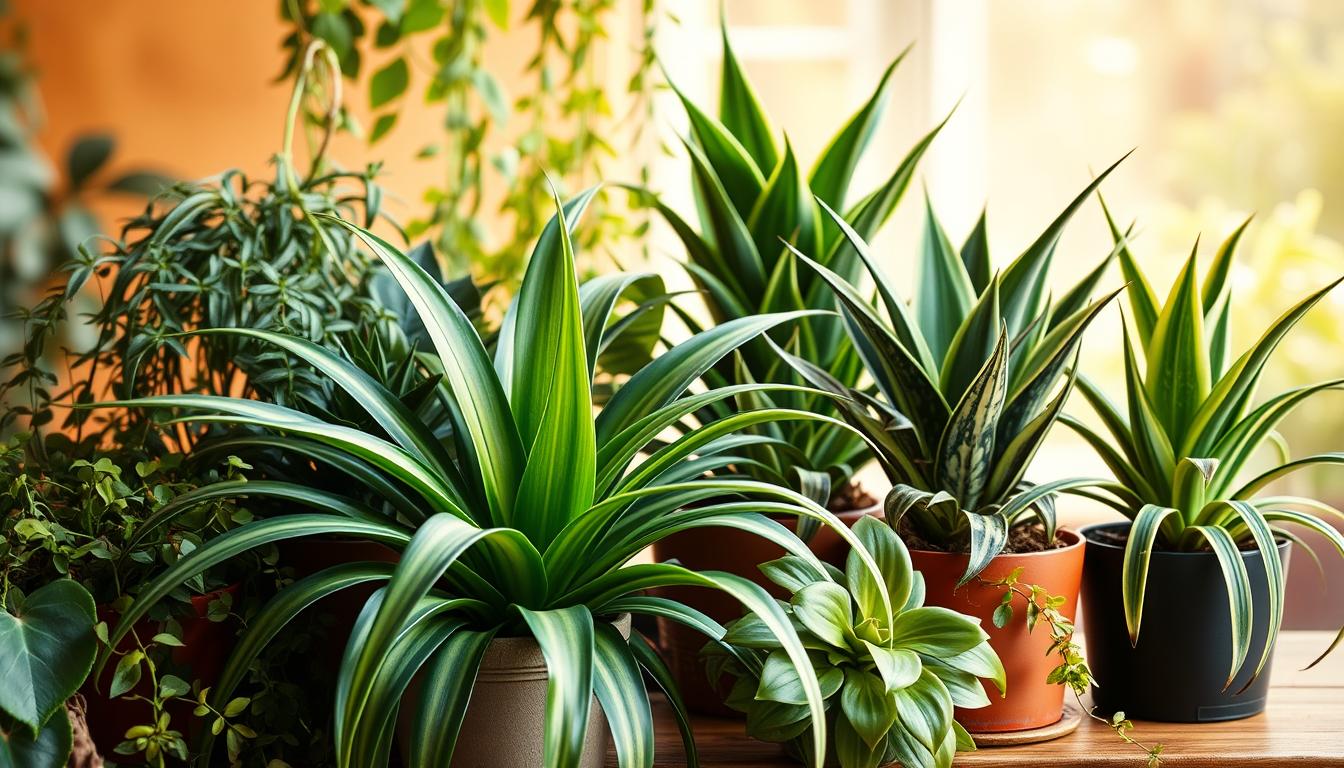Have you ever stood in the middle of your home, surrounded by the vibrant greenery of your indoor garden, and felt an overwhelming sense of peace? Spider plants, with their lush foliage and resilient nature, often become the heart of these spaces. They thrive in various conditions, making them a beloved choice among houseplant enthusiasts. Yet, choosing the right companions can transform your indoor oasis into a breathtaking display of health and beauty. In this spider plant companion planting guide, let’s explore the best companion plants for spider plants that will not only enhance their growth but also bring your indoor garden to life.
Key Takeaways
- Spider plants are adaptable and perfect for various spaces.
- Choosing companion plants enhances the aesthetic and health of your plants.
- Companion planting can improve growth and resilience in spider plants.
- Explore various options from low-maintenance to vibrant flowering plants.
- The right companions can create a flourishing indoor garden experience.
Understanding Spider Plants
Spider plants are beloved by many for their unique appearance and ease of care. Known for their striking arching leaves and ability to purify indoor air, these plants have become a staple in households across the country. Understanding the individual characteristics and requirements is essential when practicing spider plant care to keep them thriving in your home.
What Makes Spider Plants Special?
The spider plant’s ability to adapt to various environments contributes significantly to its popularity. Their distinctive foliage exhibits a vibrant green hue, sometimes displaying white stripes, making them visually appealing. Beyond aesthetics, these plants are recognized for their air-filtering capabilities, which can enhance indoor air quality. This feature makes them an excellent choice for both beginners and seasoned plant lovers.
Ideal Growing Conditions for Spider Plants
Maintaining ideal conditions for spider plants is crucial to their overall health. These adaptable plants prefer bright, indirect sunlight, as direct sunlight can scorch their leaves. When it comes to soil, well-draining mixtures are essential to prevent root rot. For optimal spider plant care, you should allow the soil to dry out partially between watering sessions. This practice encourages bushiness, contributes to a healthy growing plant, and promotes a lush appearance.
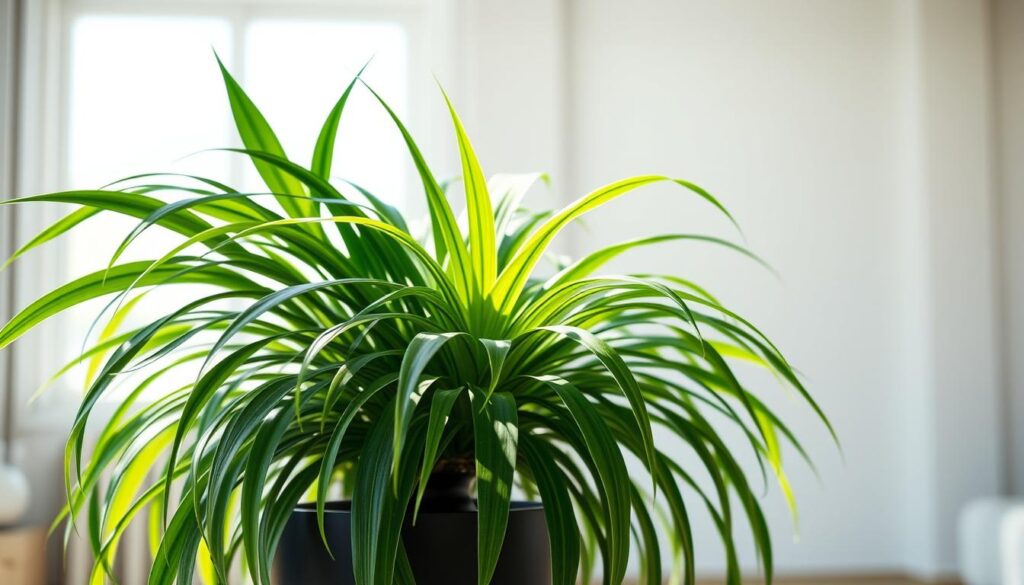
Benefits of Companion Planting
Companion planting offers a variety of advantages, especially when you consider the remarkable synergy that results from growing plants together. The relationships formed between different plants can enhance your garden’s overall vitality, leading to healthier and more productive plants. Engaging in these practices allows you to embrace nature’s design and significantly improve your gardening experience.
Why Choose Companion Plants?
Selecting companion plants provides numerous benefits, including better nutrient availability and enhanced resilience against pests. By pairing spider plants with compatible species, you cultivate a balanced ecosystem that supports natural interactions. These beneficial relationships can optimize growth while reducing reliance on chemical treatments, promoting a healthier environment in your home garden.
Enhancing Growth and Health
The most notable companion planting benefits stem from the natural cooperation among plants. For instance, some plants can deter harmful insects while allowing essential pollinators to thrive, leading to a robust gardening ecosystem. As you explore growing plants together, you’ll witness improved health and vigor in your spider plants and their companions. This diversity not only enhances the aesthetic appeal of your indoor garden but also paves the way for a thriving plant community.
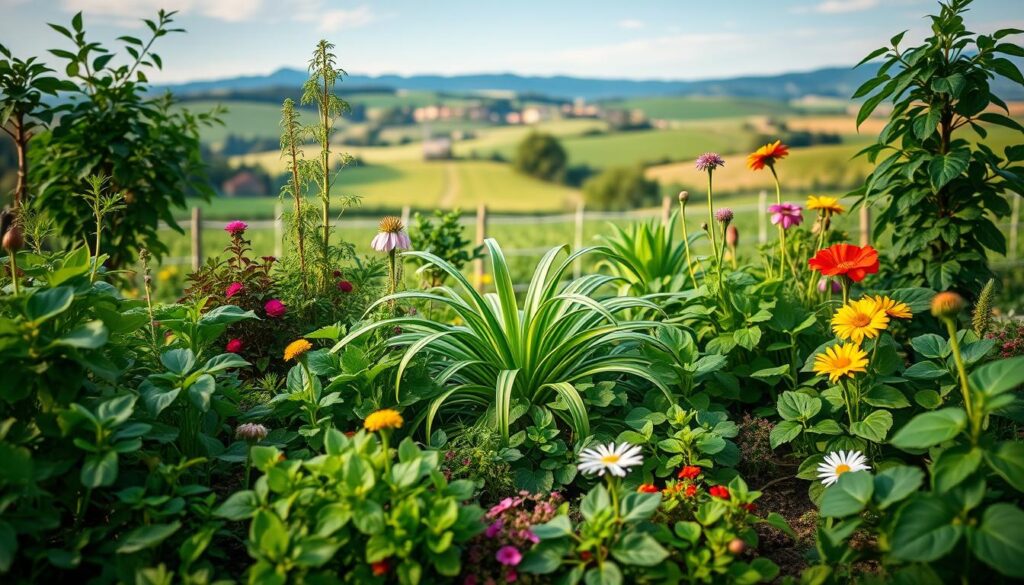
Best Companion Plants for Spider Plants
When it comes to enhancing the beauty and health of your spider plant, choosing the right companions can make all the difference. The best companion plants for spider plant not only thrive under similar growing conditions but also bring a vibrant touch to your indoor garden. Here’s a look at some fantastic options that can complement your spider plants beautifully.
Pothos: The Low-Maintenance Buddy
Pothos stands out as a wonderful addition to your spider plant companion plants list. Known for its ease of care, Pothos enjoys similar light and water conditions. Its charming trailing vines add a lush look, creating an appealing contrast with the upright growth of spider plants. This pairing promotes a healthy, thriving green space.
Philodendron: A Tropical Partner
Philodendron is another excellent choice among the best companion plants for spider plant. This tropical plant flourishes in comparable light and moisture levels, making it a seamless fit. Its large, heart-shaped leaves add an exotic touch to your plant collection, enhancing visual interest while maintaining a cohesive aesthetic.
Peace Lily: A Beautiful Companion
Peace Lilies bring both beauty and functionality to your indoor garden. With their elegant white blooms and capacity to thrive in low light, they serve as a perfect partner in enhancing the air quality around your spider plants. Adding Peace Lily to your spider plant companion plants list promotes not just a pretty sight but also a healthier living environment.

By thoughtfully selecting from these options, you can create a thriving indoor garden that not only beautifies your space but also supports the health of your spider plants.
Herbs That Pair Well with Spider Plants
Integrating herbs with spider plants can enhance your indoor space while offering culinary benefits. Two excellent choices for spider plant companion plants for indoors are basil and mint. Both herbs thrive alongside spider plants and share similar growing requirements, ensuring they bloom beautifully in your home.
Basil: A Culinary Match
Basil not only adds flavor to your dishes but also complements the aesthetic of spider plants. It prefers similar lighting conditions, thriving best in bright, indirect sunlight. When you pair basil and spider plants, you create a visually pleasing arrangement while enjoying fresh herbs for your culinary experiments.
Mint: Aromatic and Invigorating
Mint brings an aromatic quality to any indoor garden. Its invigorating scent can freshen up your space while coexisting perfectly with spider plants. Both these plants benefit from moderate watering, making them compatible pairings. The combination of mint and spider plants adds both visual appeal and delightful aromas to your living area.
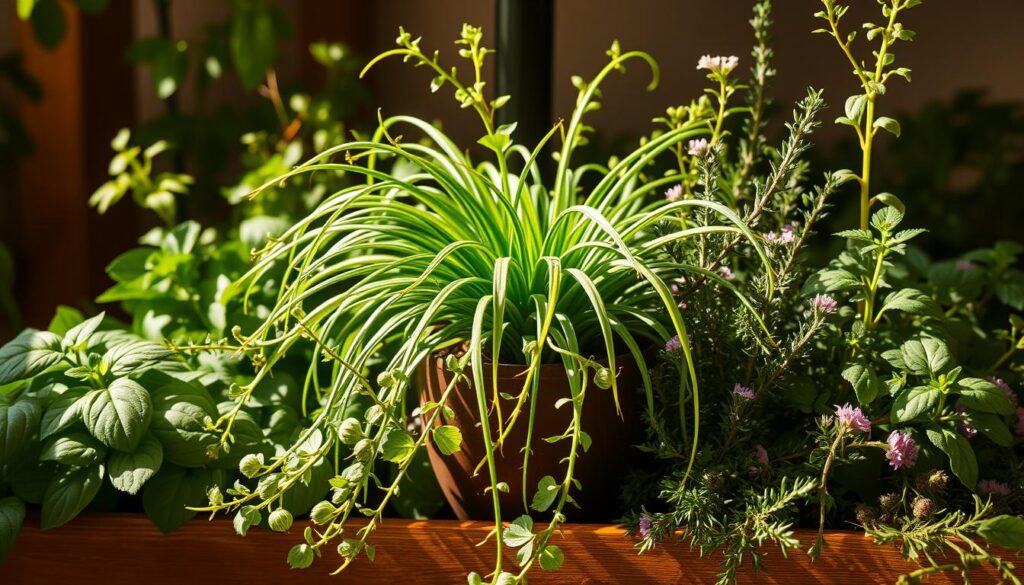
Flowering Companions
Incorporating flowering plants that go well with spider plants can elevate the visual appeal of your indoor garden. Choosing the right companions not only enhances beauty but also complements the growing conditions loved by spider plants. African Violets and Geraniums stand out as delightful options, each bringing unique charm to your collection.
African Violets: Colorful Additions
African Violets are renowned for their stunning blossoms, which can blossom in vibrant hues of purple, blue, and white. These plants thrive in similar indirect sunlight to spider plants, making them an excellent choice for a companion. The additional humidity they create benefits both species, fostering a vibrant indoor atmosphere. Including African Violets in your collection not only adds color but also enriches your space, showcasing engaging textures and sizes.
Geraniums: Classic Choices
Geraniums are another exceptional option, well-known for their classic aesthetic appeal. Their care requirements align well with those of spider plants, as both appreciate well-draining soil and moderate watering. The array of colors available in Geraniums can create a captivating contrast to the green leaves of spider plants. Merging these flowering plant companions together provides a lush and inviting environment in your home.
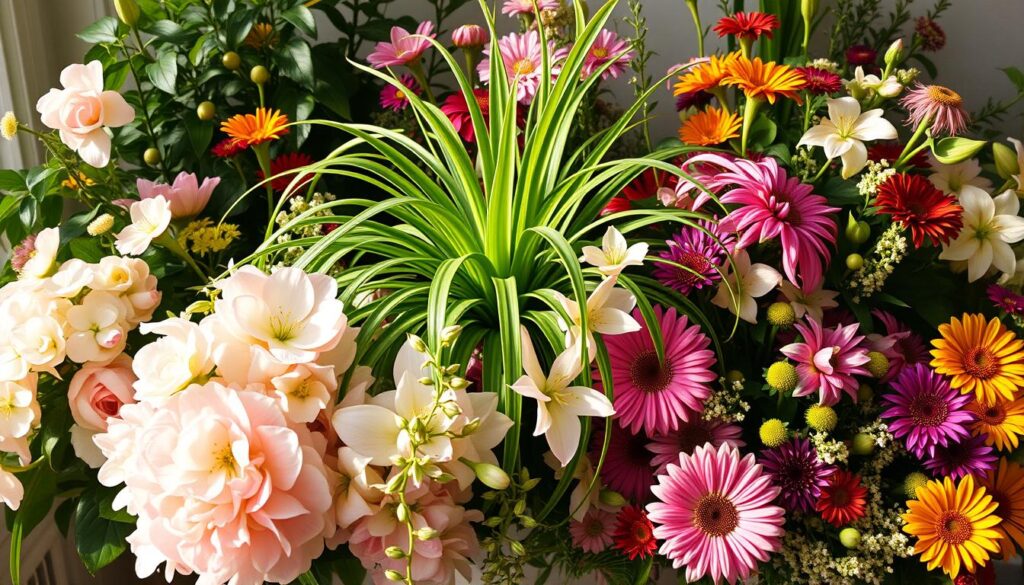
Foliage Friends to Consider
In the realm of indoor gardening, selecting the right foliage companions can enhance the beauty and health of your spider plants. Foliage plants for spider plants like Snake Plants and ZZ Plants are well-regarded for their hardiness and minimal care requirements. These plants offer an ideal balance, enriching your indoor space while being easy to maintain.
Snake Plants: Hardy Housemates
Snake Plants, or Sansevieria, bring a stunning architectural quality to your plant collection. Their sword-like leaves thrive in a variety of lighting conditions, making them perfect for pairing with spider plants. Snake Plants can withstand neglect, requiring infrequent watering, which allows you to enjoy a low-maintenance environment. Their ability to tolerate low light and dry conditions makes them a stand-out option among companion plant suggestions.
ZZ Plants: Tough and Stunning
ZZ Plants, scientifically known as Zamioculcas zamiifolia, are another fantastic choice for foliage plants for spider plants. These robust plants can flourish in low light and require minimal water, often making them the ideal roommate for your spider plants. Their glossy leaves not only beautify your indoor space but also enhance air quality. With ZZ Plants, you ensure an aesthetically pleasing and resilient gardening experience.
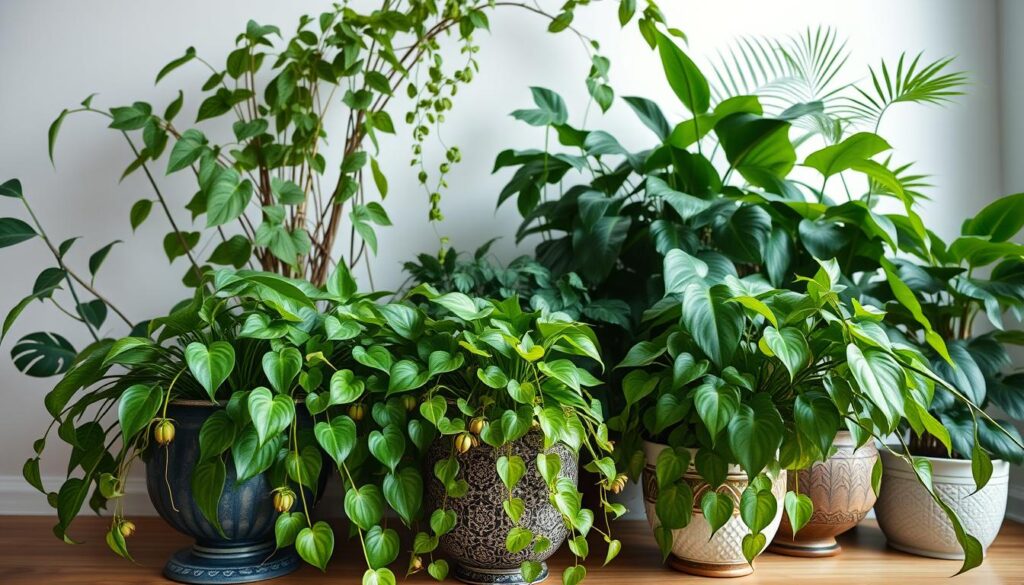
Cacti and Succulent Companions
Integrating cacti and succulents into your indoor garden can enhance the aesthetic appeal, particularly when paired with spider plants. These hardy plants not only thrive on minimal water but also contribute engaging textures and shapes. Their compatibility with spider plant compatible plants like Aloe Vera and Echeveria makes them excellent choices for your collection.
Aloe Vera: The Healing Partner
Aloe Vera stands out for its health benefits and visual appeal. Known for its soothing gel, this succulent companion plant prefers bright, indirect light, making it suitable for indoor spaces. With its striking green leaves and upright growth, Aloe Vera creates an eye-catching contrast when placed near your spider plants. Both plants have similar water needs, ensuring a harmonious environment.
Echeveria: A Unique Touch
Echeveria brings a delightful flair to your plant arrangement with its rosette shape and varied colors. It thrives in bright light and requires minimal care, aligning perfectly with the requirements of spider plant compatible plants. Grouping Echeveria close to spider plants not only enhances visual diversity but also creates a lovely display of different leaf textures, making your indoor garden a striking focal point.
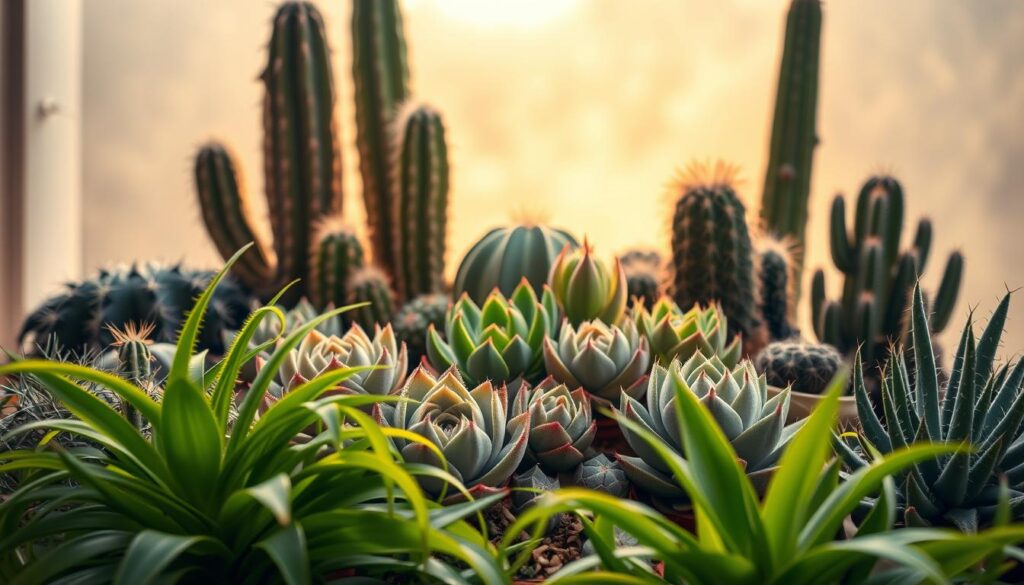
Benefits of Growing Spider Plants with Others
Incorporating a mix of plants alongside spider plants yields significant advantages for your indoor space. These pairings create a thriving ecosystem, promoting a healthy plant community that benefits each species involved. You may discover how specific plants contribute to pest resistance while enhancing soil nutrient balance.
Improved Pest Resistance
Many companion plants possess natural properties that deter pests. For instance, marigolds are renowned for their ability to ward off harmful insects, offering a protective shield for their spider plant neighbors. This mutual relationship reduces the need for chemical pesticides, leading to a safer environment for both your plants and your indoor air quality.
Balanced Soil Nutrients
The inclusion of diverse plants allows for better nutrient distribution in the soil. Legumes, which fix nitrogen in the ground, can benefit spider plants by enriching the soil with essential nutrients. This interplay between different species underscores the benefits of companion planting and promotes a balanced approached to nurturing a healthy plant community.
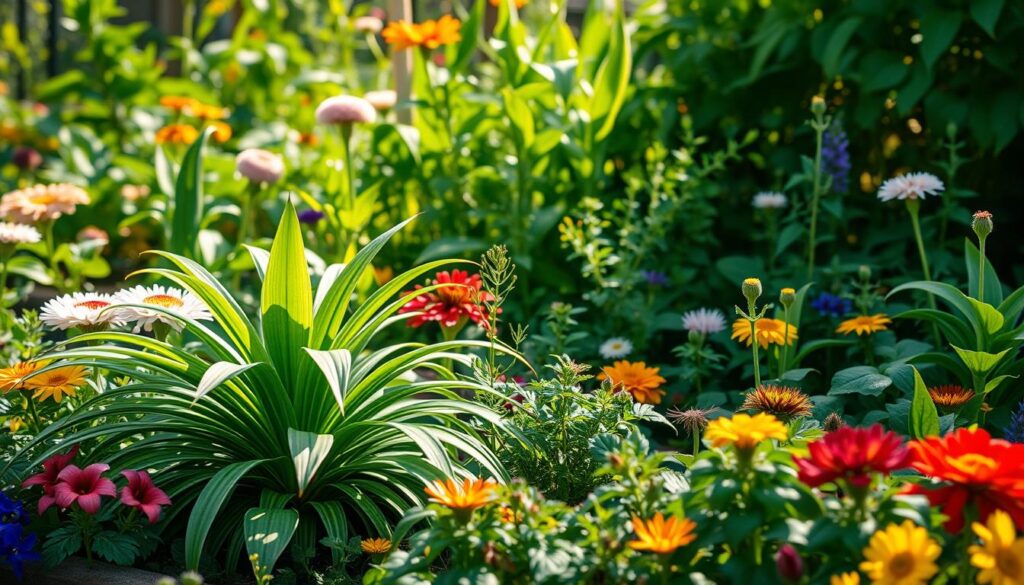
Tips for Arranging Spider Plants with Companions
Arranging your spider plants with companion plants can significantly enhance their overall health and aesthetics. Thoughtful placement ensures that each plant receives the right amount of light and space. Consider these practical arrangement tips for spider plants to create a harmonious indoor garden.
Light Considerations
Spider plants thrive in indirect sunlight, making light placement a crucial factor. Position your spider plants near windows where they can benefit from bright, filtered light. This setup not only supports healthy growth but also complements the aesthetic quality of your indoor plant spacing. Regularly monitor light exposure to ensure your plants are not exposed to harsh, direct rays that can harm them.
Pot Size and Spacing
Choosing the appropriate pot size is vital for the health of your spider plants and their companions. Ensure that each pot provides enough room for roots to expand comfortably. Aim for a spacious arrangement that allows air circulation while preventing overcrowding. This practice promotes optimal nutrient uptake and encourages healthy plant interactions, essential for effective indoor plant spacing.
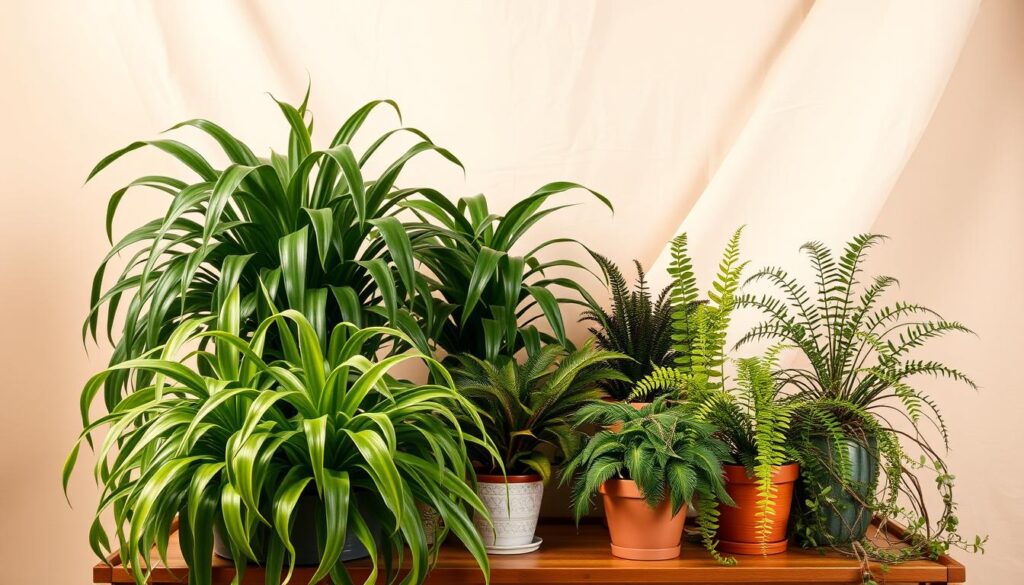
Maintaining a Healthy Plant Community
Regular maintenance is essential for a flourishing indoor garden, especially when it comes to maintaining plant health among diverse species. Incorporating effective watering and fertilization strategies creates a thriving environment for spider plants and their companions.
Regular Watering Practices
Your watering schedule should align with the specific needs of each plant. Spider plants prefer their soil to dry out slightly between waterings, preventing root rot. Check the top inch of the soil; if it feels dry, it’s time to water. For companion plants, understanding their individual moisture requirements can make a significant difference in overall health. Maintaining consistent moisture without over-saturating fosters a better community of plants.
Fertilization Tips
Tailoring your fertilization process enhances growth, particularly during the active growing season. Use a balanced fertilizer to nourish your plants adequately, supporting lush greenery in your spider plant care guide. During spring and summer, fertilizing every 4-6 weeks helps your plants receive essential nutrients. Remember to dilute the fertilizer according to the package instructions to prevent damaging the roots.

Common Challenges with Companion Plants
Engaging in companion planting brings numerous benefits, yet it is not without its challenges. You may encounter common plant issues that disrupt the harmony of your indoor garden. Understanding how to identify pests and diseases will help you maintain your plants’ health while ensuring a successful coexistence among different species.
Identifying Pests and Diseases
Pests such as aphids, spider mites, and mealybugs often target spider plants and their companions. Regularly inspect your plants for signs like yellowing leaves, webbing, or small, sticky residues on leaf surfaces. Catching these signs early allows for effective pest management, preventing infestations from escalating:
- Aphids: Small, green or black insects that suck sap.
- Spider Mites: Tiny pests that cause a speckled appearance on leaves.
- Mealybugs: White, cotton-like pests hiding in leaf axils.
Troubleshooting Plant Conflicts
Companion plants may have different needs, leading to conflicts in resources like light and nutrients. For instance, while spider plants thrive in bright, indirect light, some companions prefer shadier spots. To resolve these conflicts:
- Group plants with similar light and water requirements.
- Monitor soil moisture levels, adjusting watering routines as necessary.
- Consider using natural barriers to segregate plants that require different nutrient levels.
Employing these strategies can mitigate common plant issues and ensure a thriving plant community in your living space.
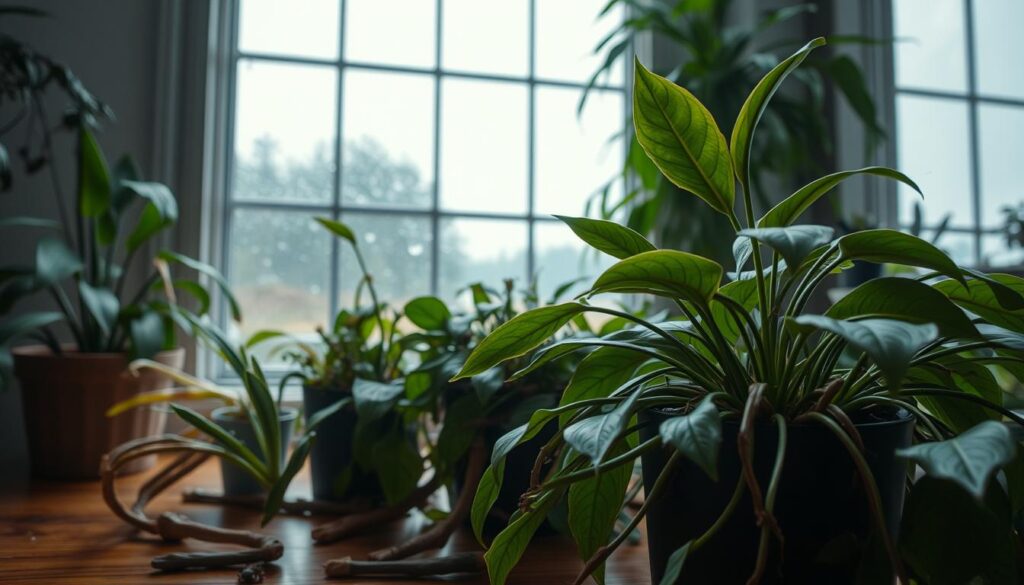
Seasonal Care for Spider and Companion Plants
When caring for spider plants and their companions, adjusting your approach based on the seasons is crucial to ensure they thrive. Understanding how light exposure and watering needs change throughout the year will help you implement effective seasonal plant care. Pay attention to these factors to achieve thriving greenery in your home.
Adjusting Light Exposure
During winter, natural light decreases, requiring adjustments in your spider plant seasonal adjustments. Place your plants closer to windows or utilize grow lights to provide adequate illumination. In the warmer months, direct sunlight may become intense, so consider moving them to a spot with filtered light to avoid leaf scorch.
Watering Needs in Different Seasons
Watering habits should reflect the season for each plant’s unique requirements. In the winter months, reduce watering frequency, allowing the soil to dry out more between sessions. As temperatures rise during the growing season, increase your watering routine, ensuring consistent moisture while avoiding waterlogging. Maintaining this balance is essential for the health of your spider plant and its companions.

Propagation Techniques for Spider Plants
Propagating spider plants is a rewarding experience, allowing you to expand your plant collection with minimal effort. By utilizing offsets or spiderettes, you can easily grow new plants. Additionally, you can enhance your indoor garden by growing companion plants from cuttings of herbs or succulents. With proper techniques, you’ll enjoy a thriving plant community in your home.
Offsets: The Best Method
Offsets, commonly referred to as spiderettes, are the most efficient way to propagate spider plants. These small plants emerge from the mother plant, developing their own roots. To propagate spiderettes:
- Choose offsets that have healthy roots.
- Carefully separate the offset from the main plant.
- Plant the offset in a well-draining potting mix.
- Provide indirect sunlight and maintain consistent moisture until it establishes.
Starting New Companions from Cuttings
Growing companion plants from cuttings can be equally satisfying. Many herbs, such as basil and mint, respond well to this method. To take cuttings successfully:
- Select healthy stems from the parent plant.
- Cut just below a node for the best rooting potential.
- Place the cuttings in water or moist soil and cover to maintain humidity.
- Wait for roots to develop before transferring to their final pots.
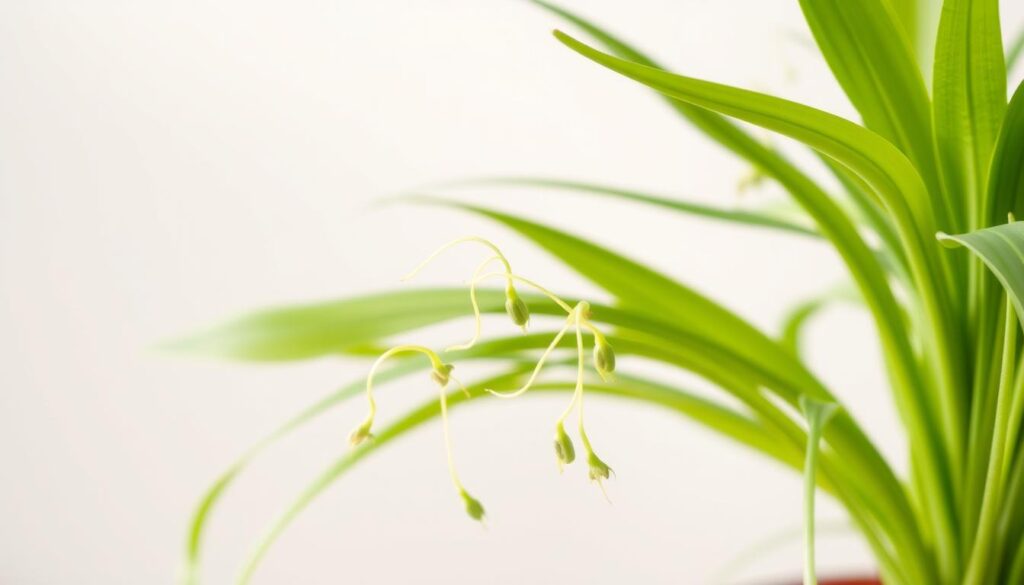
Decorating with Spider Plants and Friends
Bringing your indoor garden to life involves more than just choosing the right plants. It’s essential to consider how you showcase them through creative arrangement ideas. When decorating with houseplants, visual harmony can elevate your space, making it feel inviting and vibrant. Combining spider plants with their companions offers a unique opportunity to explore different forms, colors, and textures, resulting in stunning aesthetic plant arrangements.
Creative Arrangement Ideas
Creating beautiful displays starts with thoughtful placement. Consider grouping spider plants with lower companions like Peace Lilies, which create a striking contrast in height. Choose decorative pots that not only suit your style but also reflect the personality of the plants. Mixing textured ceramic pots with sleek metal containers can add dimension to your arrangement.
- Combine different leaf shapes for visual interest.
- Vary heights to draw the eye upward.
- Add trailing plants like Pothos to soften edges.
Balancing Aesthetic Appeal
Balance is crucial in any design. A successful arrangement features plants of varying sizes while keeping colors in harmony. You might choose a monochromatic scheme to highlight the lush green of your spider plants, or include colorful blooms to inject vibrancy into your layout. The key to decorating with houseplants lies in arranging elements so that they complement rather than compete with each other.
| Plant Type | Height | Foliage Type | Pot Style |
|---|---|---|---|
| Spider Plant | 12-24 inches | Long, arching leaves | Ceramic |
| Peace Lily | 12-18 inches | Broad, glossy leaves | Plastic |
| Pothos | 10-30 inches | Heart-shaped leaves | Hanging Basket |
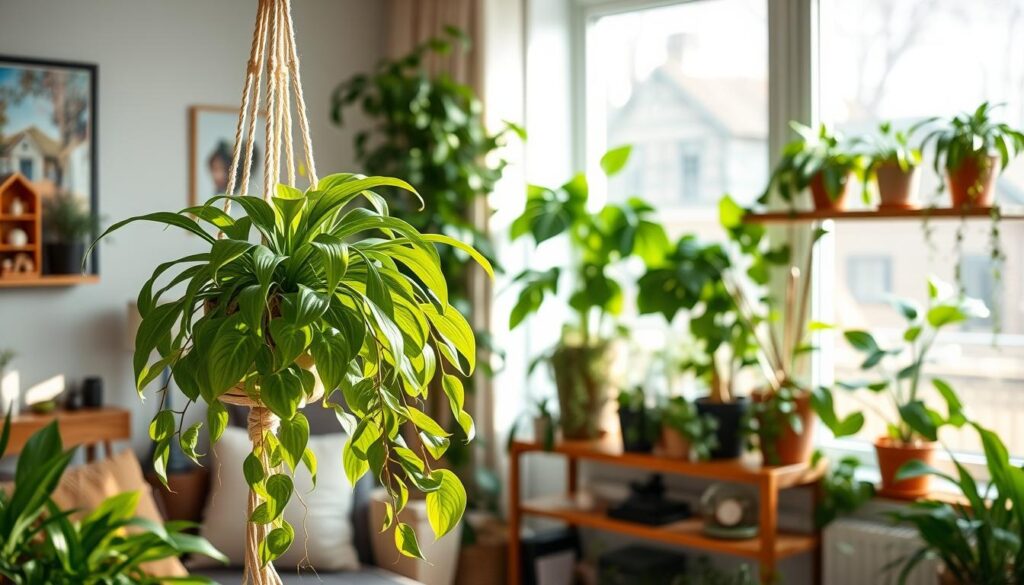
Final Thoughts on Spider Plant Companions
As you explore the world of spider plant companion plants benefits, you’ll realize that embracing diversity in your indoor garden is essential for creating a thriving ecosystem. Each companion brings unique qualities that can enhance the overall health and aesthetics of your space. From vibrant flowering species to lush foliage options, the variety allows you to curate a lovely assortment that reflects your personal style and care preferences.
Nurturing your living space doesn’t just mean watering your spider plants; it involves striking a balance between different plant types that thrive together. By thoughtfully selecting companions that cater to various light, water, and nutrient needs, you set the stage for an indoor garden diversity that flourishes. This harmonious mix not only promotes growth but also creates a more visually engaging environment for you to enjoy.
Taking the time to understand the dynamics between your spider plants and their companions can lead to better outcomes in your gardening journey. Whether you opt for low-maintenance housemates like Pothos or vibrant flowers like African Violets, each choice contributes to a lively atmosphere that enriches your home. Keep exploring the benefits of this companionship, and soon you’ll find yourself surrounded by a beautiful, flourishing garden.
